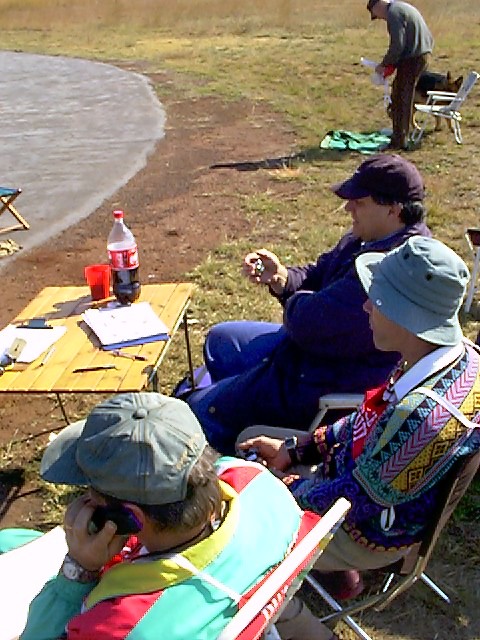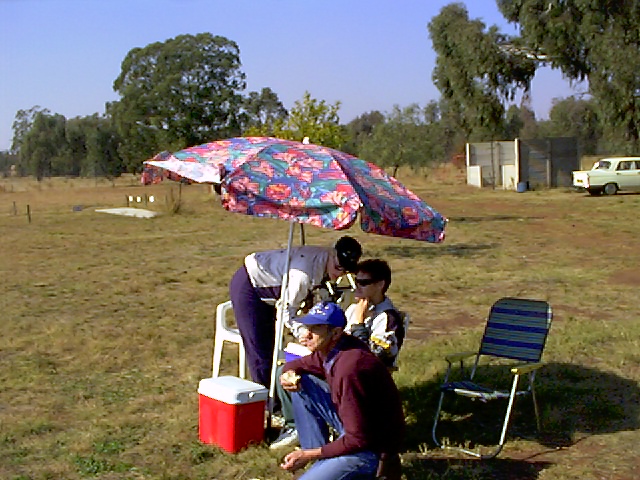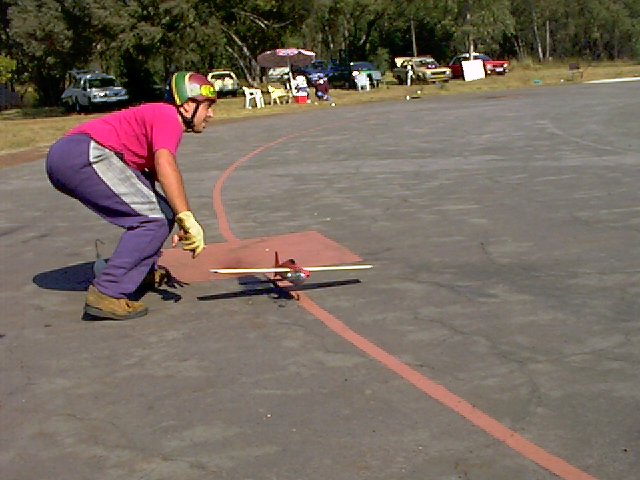
5000 Lap International Postals
20 May 2000
It
began some months ago on the Internet where a lengthy discussion started on the
control-line racing mailing list about a 5000-lap/500km event. The event was
coined as "FLIP", Five thousand Lap International Postal. Interest was
kindled in South Africa to take part in the event. It was to be held during May
2000, as a postal event with possible Guinness Book of Records acknowledgement.
After some local discussion, several people indicated their intent, and three
South African teams were provisionally formed, intending to make their attempt
on 20 May. They were:
Fred
Schulze/Peter Marais/Vaughn Swallow
Graham
Swallow/Henry Kurowski
Lionel
Smith/Peter Lott/Alan Smith
The
three-member teams had decided amongst themselves that they were not fit enough
to endure 5000 laps alone, which, in hindsight was a good decision. After some
canvassing, sufficient officials volunteered to run the event for which the
entrants were very grateful.
The
week before the event passed with mixing of large quantities of fuel. Everyone
had elected to use diesels due to their frugal fuel consumption. Friday the 19th
May dawned to a cold, very overcast Pretoria area. The 5000 lap international
postal event was due to be held on the 20th, starting in the morning
and hopefully being complete by about 1400 which would allow time for the F2B
team to practice on the only one tar circle. Friday afternoon entertained some
pouring rain and even thunderstorms in the Gauteng province, a most unusual
event only one month before mid-winter in the Southern hemisphere.
Saturday
morning dawned, and the few worried entrants breathed a sigh of relief when the
sun rose to reveal a beautiful day. Graham's team-mate withdrew so he (also
breathed a sigh of relief?) graciously agreed to help run the event with the
remaining two teams. The New Rock Control-Line flying field is situated near
Pretoria, at 4200ft above sea level, and temperatures were expected in the 10°C
to 20°C range for the morning. Being winter, it gave us some welcome relief
from possible heat exhaustion and dehydration.
The
Lott/Smith2 team entered and flew a Li'l Quickie Open class model
with Nelson .15 RI SE and a 120c tank. All three team members took turns in
piloting and pitting, fortunately, the other team was stopping often, so to
schedule a pitstop and mechanic change when the other model was also on the
ground was not difficult. Pilot changes were only made at safety recesses. The
Lott/Smith2 team also had a backup, a Pitts Special with PAW 249
TBR2, essentially a Goodyear class model.
Schulze/Marais/Swallow
used a Li'l Quickie Goodyear class model with a PAW 249 TBR GT and the requisite
30cc tank. Pilots were Peter Marais and Vaughn Swallow, pitmen were
(predominantly) Fred Schulze and secondarily Peter Marais, with Graham Swallow
standing in for a few.
After
setting up of aircraft, scrutineering, briefing, making officials comfortable,
setting up mobile workshops adjacent to the circle, etc… the countdown was
started at about 09h30Z. Peter Marais and Peter Lott commenced piloting for
their respective teams with Fred Schulze and Alan Smith pitting. Ambient
temperature was about 10°C, good for comfort. By the way, two teams in Arizona,
USA, flew in temperatures up to 41°C! They earn my respect for sure.
All
models got away promptly, the pilots settled quickly into the groove, the sound
of "soft" set diesels filling the morning air. Lott/Smith2
started out very well doing 180 laps on a tank so pit stops were minimal. Minor
engine settings were made on the first two of pit stops, after that the Nelson
seemed to find a rhythm and the setting was not changed for the next 3000 laps-
Impressive!
The
Schulze/Marais/Swallow team were stopping every 36 laps or so for their 30cc of
fuel. Their PAW had about 20 minutes of running in time before the race: It ran
well for about 500 laps, despite abundant oil (20% Castrol M) and a
"soft" setting, then proceeded to "run out" even more
quickly. After the second safety recess, they became plagued with a faulty shut
off, then restarting problems. However, this team provided the days
entertainment when they took off with a rag, used to wipe excess oil, draped
itself over the outboard tailplane. The rag stayed with the aeroplane for half a
lap before departing again. Lionel, who was piloting at the time, was heard to
mutter, " Hey, this isn't combat!"....
Lott/Smith2
experienced some vibration with Peter flying at about 3500 laps. Initially, it
was put down to engine setting, which by now sounded a bit "hard", so
the compression setting was backed off a bit, to no avail. The shutoff then
started to trip on it's own, which necessitated a quick modification with a file
by Lionel, however this failed to fix it so the whole tank/shutoff unit was
changed, requiring a 6 minute pitstop. This cured the problem for a while, but
the vibration was getting worse still. At about 3950 laps, a final pitstop was
made and the officials had a look at the aircraft from a safety point of view.
The engine seemed secure, so the team continued and finished the 4000 laps. The
safety recess allowed the engine to be removed, which revealed that the engine
mount was cracked completely through. The engine plate was, in fact, held on by
only two screws.
With
no spare, it was very quickly decided to revert to model No. 2. This created a
problem, as we had given away the PAW's fuel and had to make an extremely
uncalibrated addition of Castor oil to the Nelson's fuel to get something that
the PAW would digest. Fortunately, Lionel had a small supply of castor so this
was done, and a large amount of scurrying around, refuelling, etc occurred to
get the plane and lines into the circle before the last 1000 laps commenced. The
PAW, which had not run since the National in March, was sent off only about 10
seconds after the start signal with no warm-up and no changes in setting. Luck
was on the team's side as the setting was great, and after the first 80 laps
required only minor adjustment. By this time, temperature was up to about 20°C
and the PAW was going better than ever before. Have you ever made a batch of
fuel that works really well but you don't know what the final composition really
was?
The
Lott/Smith2 team crossed the line at exactly 4h 43min 22sec,
excluding safety recess time, at which time the other team with the Goodyear
model, which had been having problems, decided to retire after doing 2357 laps
and some 70 pitstops.
This report was published 2 days after the event and everyone is complaining about sore and stiff muscles. Hot baths and massages required for sure!
Some
thoughts:
The
engines Lott/Smith2 used were running at +/- 18000 air RPM. In the
4:43:22 time, the Nelson piston accumulated just over 4 million cycles and the
PAW 1 million!!
Once
again, a VERY BIG thanks to Roston Dugmore, Graham Swallow, Nic van der
Westhuizen, Nigel Soden, Jan, Antoinette and Charmaine Doherty, the officials
without whom there would have been no event!

Teams that participated in the FLIP Goodyear: L to R, Peter Marais, Fred Schulze, Vaughn Swallow in one team, Lionel Smith, Alan Smith, Peter Lott from the other team

Pitstop Time

Officials: Top to bottom Nigel Soden, Roston Dugmore, Graham Swallow.
Roston and Graham were CD's of the event and doubled up as lap counters and timekeepers

Officials: Top to bottom Charmaine, Antoinette and Jan Doherty, timekeepers and lap counters.

Graham Swallow with a pitstop - yes, he stood in for some when team members were running out of steam.

Lionel Smith releasing the model somewhere between 2000 and 3000 laps